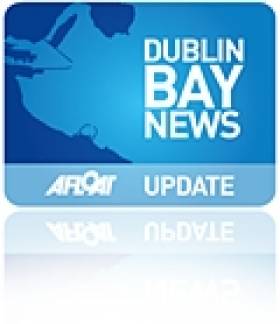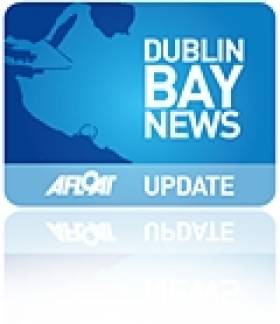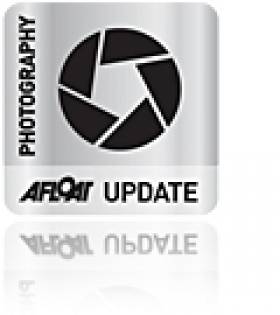Displaying items by tag: Dublin Bay
Royal St George Win Cumberland Cup
With a close to perfect score, Andrew Fowler's team of Sam Hurst, Brendan Fafliani, John Sheehy, Nick Smyth, Guy O'Leary, Peter Bailey and Phil Lawton from Royal St George YC in Dublin, won the 2010 Royal Thames Cumberland Cup from Ian Ilsley's team from Yacht Club de Monaco writes Malcolm McKeag. Firm friend and arch-rival of the home side the Southern Yacht Club of New Orleans was third, claiming by dint of that result the Bourgne Cup, contested on each and every occasion the clubs meet, in whatever larger competition..
Over three days at Queen Mary Water hard by Heathrow airport the seven teams sailed a total of 54 races in the international yacht club contest, ferried to and fro from the RTYC's Knightsbridge clubhouse in that iconic symbol of London, a bright scarlet Routemaster double-decker omnibus.
Sailing in a fleet of eight carefully-matched modified J80s the competition began with a two-day double round-robin in which each team raced each other team twice. St George topped the league, winning 11 out of their 12 matches and losing only to the hosts and current holders, Royal Thames, and thus apparently setting the scene for the finals. It was a scene dramatically re-shaped by the winner-take-all nature of the Cumberland Cup's competition structure.
With teams travelling from across the globe to compete in this regatta, the organisers deliberately eschew a competition format that eliminates teams early from the competition, espousing instead a format that keeps every team sailing into the final round. The result is The Ladder, which as some teams including the hosts found to their cost might be better termed The Greasy Pole. On The Ladder, a win carries the double bonus of promotion to the next rung – but every loss earns the double-penalty of relegation. On The Ladder, it is just possible by dint of really good sailing to redeem a disappointing result in the round-robin and climb all the way to the top – as did the Monegasques – while the series leaders – in this case the Irish – must not put a foot wrong if they are to retain their fingertip grip on the crown.
Thus on Sunday The Ladder's first and lowest rung saw the Germans face-off against the Kiwis for a chance for stardom, while Royal St George had to wait patiently to see which of the Yanks (and it's not often the team from New Orleans are called Yankees!) and the Brits would be first to step up to try and knock them off their perch. As matters transpired, it was Royal Thames who beat the Southerners to race against the champs: to no avail. Royal St George won.
After Round One, the Brits began what turned out to be their slide down The Ladder, while the visitors from the Mediterranean climbed ever higher. The Southern, meanwhile, had to dispose of Royal Port Nicholson if they were to have a chance, in Round Three and the final round of The Ladder, of another crack at the leaders.
With Port Nich out of the way, the crunch race in Round Three was that between the Southern – highly vocal as always – and Monaco, who had quietly beaten Royal Thames when Ben Clothier of the host club earned a penalty for inadvertently but illegally 'sculling' the boat with the rudder while trying to slow down to block his rival. Given that in the round-robin YCdeM had lost almost as many races as they had won (and then been penalised a further point for a violent T-bone collision in their early race against St George) it is not unkind to suggest that their presence, by Round Three, on the top rung of The Ladder had been predicted by few. But Ian Ilsley, their team captain who by his own admission 'hadn't team raced for years' had by now earned both the respect of his rivals and the nickname 'the Old Fox'.
Southern, in blue jackets, began by blowing the yellows away at the start to be a comfortable and apparently safe 1-2 at the windward end of the course – but somehow one of the YCM team managed to get close enough on the long run to engage a blue boat and suddenly it was Game On again. On the final beat all four boats were mixed together and the denouement came – as so often in this two-boat team racing where the crucial factor is that the team with the boat in last place loses the match – at, beyond, above and back round again to the finishing line, with a Southern boat blocking out one Monaco boat only to find his own way back blocked by the other Monaco boat. And vice versa. Finally a Southern boat crossed the finish line – only to cop a penalty by blocking the path of the last returning Monaco boat under the rule that says a boat no longer racing must not interfere with one that is still racing.
And so it was a Monaco-Ireland final. If anyone thought this would be a walk-over for the Irish, they were wrong. Monaco had their tails up and no mistake. Once again it was their down-wind sailing that kept them engaged and it was not until the final mark, when the Monaco boat in second earned a penalty, that it really was Game Over.
Monaco were justly pleased with their Ladder climb from 4th place after the Round Robin – but none could nay-say the Irish for their win. 15 matches sailed and only one of them lost.
Photos below and on our gallery by Ingrid Abery





More photos here on our gallery.
Four fleets Contest Royal Alfred's Baily Bowl
There will be a light start this morning to the Royal Alfred's Baily Bowl event on Dublin bay. The Dublin Club will provide a full weekend of racing run from the National Yacht Club. Three races on Saturday and two on Sunday. The biggest fleet will no doubt be the SB3 fleet sharing the windward-leeward course with the Dragons. Also racing is the Squib and Flying fifteen classes. First gun at 1100 hours. Report here later.
Expedition Liner Visits Cork and Dublin
An interesting visitor to Dublin Bay this morning is the MS Fram, a 500-passenger capacity cruise ship that has been designed with a reinforced hull for cruising arctic waters. The Norwegian ship cruised from Cork overnight. It has a four star rating from www.choosingcruising.co.uk and more details are here. MS Fram is operated by the Hurtigruten ASA Group. The ship made its first maiden voyage to Greenland in May 2007.
Three Cruise Liners Arrive in Dublin Port
Of the 86 Cruise liners due in to Dublin Port this Summer, three are docked in the Capital's port today, two arriving after 7am this morning.
Cruise liner traffic into Dublin is in line with last years figures when almost 80 cruise liners visited the port in 2009, carrying 120,000 passengers and crew to Dublin.
The 139 metre long Spirit of Adventure, the 163 metre Ocean Countess and the largest blue hulled Marco Polo at 176 metre contribute significantly to the Dublin economy.
The port company estimates that cruise liner visits generate in the region of €35 million to €50 million for Dublin’s economy.
Dublin is Ireland's most popular port with cruise liners. 75 visited Dublin in 2006, numbers have grown despite the down turn. Smaller liners can come up the River Liffey close to the city centre while the larger ships berth in Alexandra Quay, which is only 2 kms from the city centre.
Cruise Liner websites
Gaff rigged and traditional boats are welcome to join the Dublin Bay Old Gaffers Association in a celebration of traditional sailing and music and craic on the week-end of May 28th-30th. It is part of Poolbeg Yacht and Boat Club's annual regatta and
festival sponsored by Dublin Port Company.
The weekend will begin with registration and reception on Friday night followed by a race in Dublin Bay on Saturday Starting @11:30 at Poolbeg Lighthouse.
On Saturday evening there will be a Hog Roast, music and craic until late.
Sunday will include the Blessing Of The Boats at Poolbeg followed by a Parade of sail up through the East link and the Samuel Beckett Bridges and returning back down to Poolbeg Marina.
Prize giving will take place @17:00 hours in Poolbeg Club house. Sunday evening will conclude with Music and socialising .
Poolbeg Yacht and Boat Club Have Kindly agreed to facilitate all registered and participating boats, free berths on the Marina for the week end.
Dublin City Council is to conduct a major marine site investigation works in Dublin Bay to provide a detailed understanding of the sub-seabed. The works will assist the Council in determining the feasibility of constructing a tunnel to extend the existing effluent outfall to a point approximately 10 kilometres eastwards in Dublin Bay.
To assist in the final decision regarding the technical feasibility and overall viability of extending the existing efluent outfall in the Bay, it is necessary to obtain a detailed understanding of the following in the Bay area; Sea Bed Bathymetry, Sea Bed characteristics, Sub-seabed sedimentology and underlying bedrock geology (rock types, faults, folds, structures, characteristics etc.). The full tender notice is here.
Raging Bull Wins Blustery ISORA Race
Matt Davis sailing Raging Bull (a Sigma 400) took first place overall in the second race of the ISORA series sailed in blustery conditions on Saturday. ISORA newcomer Ken Grant and “Tigh Soluis” took second overall and first in Class two. “Galileo” took third Overall and second in Class 1. “Tsunami” took third in Class one while “Legally Blonde” took second Class two and “Lula Belle” took third in class two.
From an entry list of 26 boats, 20 boats came to the line in Dun Laoghaire for the 2nd ISORA race and the first in conjunction with the Royal Alfred Yacht Club and their Lee Overlay Offshore Series. The fleet had two newcomers to ISORA- “Rollercoaster” and “Tigh Solus”.
The wind remained constant for the entire race North- East, 20-25 knots. The tide also was ideal with a south going tide for the leg to Arklow North, turning as the fleet rounded to go north to Dun Laoghaire. The wind and tide gave a fast invigorating race. Even the sun shone. It was perfect offshore conditions.
With a beam reach to the Muglins and a reach down to North Arklow the fleet kept very tight. There was even crowding for some boats rounding North Arklow. The close proximity of the boats kept all the crew driving their boats for the duration of the race.
The leg to the Muglins, before turning into Dublin Bay for the finish at the Harbour lighthouses, was a long leg- short leg beat. Due to the north-easterly that had been blowing for some days the seas were rough and extreme care had to be taken to steer the boats around the breakers.
The first boat to cross the finish line was “Galileo”, Tennyson, Lemass and Kelliher. It was followed closely by Matt Davis’s fast Sigma 400 “Raging Bull” with “Tsunami”, Vincent Farrell close behind. The entire fleet finished the 50 mile course within two hours of “Galileo”.
The next race is next weekend 15th May from Holyhead to Dun Laoghaire. It is a 75 mile race. This is also the feeder race to the ICRA Championships being run in the Royal St. George Yacht Club. Results attached.
Persistence Pays off in DBSC White Sail Fleet
Westerly winds gusting to over 10 knots provided ample breeze for the first Dublin Bay Sailing Club Thursday race of the season. Colin Galavan's Design Security was the winner in a large turnout of SB3s and Charles Broadhead's Persistence was the winner of the White Sail Cruisers on ECHO handicap. A full set of sailing results is published here.
DUBLIN PORT Dublin Bay Sailing Club Results for 29 APRIL 2010
BENETEAU 31.7 Echo- 1. Attitude (D.Owens/T.Milner), 2. Magic (D.O'Sullivan/D.Espey), 3. Prospect (Chris Johnston)
BENETEAU 31.7 - 1. Magic (D.O'Sullivan/D.Espey), 2. Attitude (D.Owens/T.Milner), 3. Prospect (Chris Johnston)
CRUISERS 0 Echo - 1. Tsunami (Vincent Farrell), 2. Lively Lady (Derek Martin)
CRUISERS 1 Echo - 1. Jalapeno (Dermod Baker et al), 2. Something Else (J.Hall et al), 3. Another Adventure (Darragh Cafferkey)
CRUISERS 1 - 1. Jalapeno (Dermod Baker et al), 2. Joker 11 (John Maybury), 3. Something Else (J.Hall et al)
CRUISERS 2 - 1. Jawesome 11 (V.Kennedy/M.Dyke), 2. Peridot (Y Charrier et al), 3. Red Rhum (J Nicholson)
CRUISERS 2 Echo - 1. Red Rhum (J Nicholson), 2. Peridot (Y Charrier et al), 3. Jawesome 11 (V.Kennedy/M.Dyke)
CRUISERS 3 Echo - 1. Gung Ho (G & S O'Shea), 2. Lady Rowena (David Bolger), 3. Jiminy Cricket (Mona Tyndall)
CRUISERS 3 - 1. Gung Ho (G & S O'Shea), 2. Supernova (K.Lawless et al), 3. Cries of Passion (Bryan Maguire)
FLYING FIFTEEN - 1. Fifty Somethings (David Mulvin), 2. Deranged (C.Doorly), 3. Flyer (Niall Coleman)
GLEN - 1. Glendun (B.Denham et al), 2. Glencorel (B.Waldock/K.Malcolm), 3. Glenshane (P Hogan)
RUFFIAN 23 - 1. Ruff Nuff (D & C Mitchell), 2. Ruffles (Michael Cutliffe), 3. Diane ll (Bruce Carswell)
SB3s - 1. Design Security (Colin Galavan), 2. Blue Bird (Cathy McAleavy), 3. Sin Bin (Barry O'Neill)
SHIPMAN - 1. Poppy (Peter Wallis et al), 2. Whiterock (Henry Robinson), 3. Curraglas (John Masterson)
SIGMA 33 - 1. Popje (Ted McCourt), 2. Rupert (R.Lovegrove/P.Varian), 3. Enchantress (Michael Larkin et al)
SQUIB - 1. Aquabats (Brendan Fogarty), 2. Absolutely Fabulous (N Kennedy/P Reilly), 3. Anemos (Pete & Ann Evans)
WHITE SAIL CRUISERS Echo - 1. Persistence (C. Broadhead et al), 2. Afternoon Delight (Michael Bennett et al), 3. Lucy O (Aonghus O hEocha)
WHITE SAIL CRUISERS - 1. Persistence (C. Broadhead et al), 2. Windshift (R O'Flynn et al), 3. Arwen (Philip O'Dwyer)
Youths Gather for Bay Event
This May Bank Holiday weekend (01-03 May 2010) over 300 boats from seven different classes will race on three separate courses in Dublin Bay. The format for this year’s event is based on that of the ISAF Youth World Championships which will be hosted by Dublin Bay in 2012.
Many of the junior sailors who will be targeting qualification for the 2012 Youth Worlds will be competing in the Optimist Class at the Mitsubishi Championships as sailors must be under 18 years of age in 2012 in order to qualify. There will be over seventy Optimists competing for this years World, European, and Under 12 squads.
The Laser Radial, Laser 4.7 and 420 Classes will also be fighting it out for Irish team places too with the prestigious 2010 ISAF slots also up for grabs. The 2010 ISAF Youth Worlds will be held in Istanbul in July and Ireland will be represented at this event by the leading sailors in all 3 classes.
The Junior Pathway classes, Topper’s and RS Feva’s will also compete along with the SL 16 catamaran which makes its debut on the bay in preparation for 2012 where it will be a class. The introduction of the SL class two years in advance offers sailors a fresh opportunity to train and qualify in this new class to Ireland.
www.dublinbay2012.com has been set up by the organisers to assist sailors and clubs to prepare for the prestigious Youth Worlds. Full details of all pre-event activities are available on this site including a link to the Mitsubishi Motors Youth Championships 2010.




































































